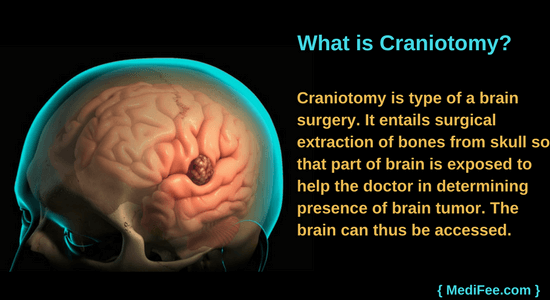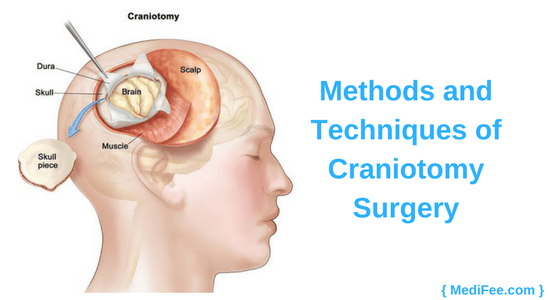Craniotomy
Listed below is the step by step procedure of craniotomy:
- What is Craniotomy?
- Why is Craniotomy Required?
- Pre-operative Preparation
- Day Before Surgery
- Procedure Day
- Methods/Techniques of Craniotomy
- Post Procedure
- Risks and Complications
What is Craniotomy?
Craniotomy is type of a brain surgery. It entails surgical extraction of bones from skull so that part of brain is exposed to help the doctor in determining presence of brain tumor. The brain can thus be accessed.

Why is Craniotomy Required?
Craniotomy is performed for a number of reasons including:
- Device implant: Craniotomy may be done while performing stimulator device surgery for treating neurological diseases like Parkinson's and the like.
- Blood clots: Serious head injuries, clots that spread from some other part of the body to the brain and hardened arteries are the factors responsible for blood clot formations in the brain. Craniotomy can be useful in removing these blood clots.
- Brain tumor: It is a preferred surgical solution for patients suffering from tumors or lumps in the brain.
- Brain abscess: A brain abscess is a serious medical condition. In it, bacteria infest tissues in the brain after an accident or injury to brain. Craniotomy is the surgery that entails removing out the abscess in entirety.
- Skull fractures: Any breaking of skull bones because of accidental injury is treated through craniotomy. However, decision of opting for surgery depends on intensity and location of fracture along with age and health status of person.
- Microvascular decompression: Pressure on cranial nerves, that are responsible for providing facial sensation causes symptoms, such as pain and facial spasms. It is treated with the help of opening up of skull through craniotomy.
- Foramen magnum decompression: Chiari malformation is a condition wherein there is an abnormality that happens because of lower part of brain entering into the spinal canal. Removal of pressure thus caused from the back of the brain is possible through a craniotomy. Foramen magnum decompression is a specific type of craniotomy designed for treating this disorder.
Pre-operative Preparation
- Physical examination: In addition to a complete medical history, your doctor will conduct a physical exam to ensure you are in good health before you undergo surgery.
- Blood tests: Complete blood count (CBC) is ordered to know the person's immunity and platelet status.
- Arteriogram: An arteriogram also referred to brain angiogram involves insertion of catheter into a blood vessel and the subsequent introduction of a contrast agent through the catheter. X-ray images are taken of the blood vessel that in turn reveals the extent of damage of the blood vessel.
- Brain scan: MRI or CT scan is ordered for helping the surgeon study the inner structures and brain nerves that are actually damaged and require surgery for treatment.
- Electrocardiogram: An electrocardiogram gives idea of heart health of patient to surgeon and whether the heart is capable to handle surgical pressure.
- Preoperative neurological exam: There will be a preoperative neurological exam whose results will be compared with a post operative exam.
- Pregnancy: If you suspect that you are pregnant or think that you might get pregnant in few days before surgery, discuss this with your doctor.
- Sensitivities and allergies: It is better to tell your doctor beforehand if you have allergies to certain anesthetic agents, drugs, medicines, latex etc.
- Medicines you are taking: Also show all your medicine prescriptions to the doctor so that they know what all medications you are on beforehand.
- Blood thinners: If you are on any blood thinning prescription drugs, do discuss the bleeding disorder with doctor. It may be required to be discontinued as that causes blood clotting.
- Quit smoking: If you smoke, you should stop smoking as soon as possible before the procedure to improve your chances of a successful recovery from surgery and to improve your overall health status.
Day Before Surgery
- Antiseptic shampoo: You may be prescribed an antiseptic shampoo to wash your hair with, on the day before the surgery.
- Consent form: A consent form is given to you that requires you to give written permission to the doctor for surgery. Do read the form carefully before signing it.
- Fasting before surgery: You will be asked to remain on an empty stomach on the night before the procedure.
- Surgical queries: You may want to discuss your queries and doubts regarding the surgery with your doctor.
Procedure Day
- Sedation: Sedation is administered to you before surgery that makes you relax.
- Shaving: The patient's scalp has to be shaved and the skin has to be cleaned with an anti-septic solution before
- Intravenous line: Intravenous line is attached to your hand.
- Hospital gown: You will be asked to change into a hospital gown. Also, remove accessories, jewelry, wedding band before coming to hospital.
Methods/Techniques of Craniotomy
To begin the surgery, general anesthesia is given. You are positioned on the operation table such that a special 3 pin device keeps the skull in proper position throughout surgery.
A drain is inserted in your lower back that has the purpose of removing cerebral spinal fluid during surgery. The scalp is thereafter cleared for operation after shaving it.
Incision is made on the nape of the neck depending on the site of injury. The scalp is clipped to access the brain and also limit the loss of blood. A surgical drill is used to drill small holes on skull. A bone flap is cut with the help of a saw. The flap thus created is then exposed for making the brain tissues visible to the surgeon.

Intracranial pressure (pressure inside skull) is measured using a special device placed in brain tissue. The surgeon then stitches up the brain tissue. The bone flap is returned to its original place with wires and screws. The blood pressure, pulse and body temperature are continuously tracked during surgery.
Post Procedure
- Immediately after procedure, you will be shifted either to a recovery room or intensive care unit (ICU)depending on your condition. The respiratory support is kept working till you regain consciousness and effects of anesthesia wear off.
- You will be shifted out of ICU, once the vital signs are stable. Also, vital signs are checked constantly even after shifting you to recovery room.
- Few tests for assessing your nervous system changes and functioning are done at regular intervals during your hospital stay.
- A urinary catheter is placed in the bladder for collecting and draining urine.A physiotherapist will teach you deep breathing exercises. Other exercises are also taught to increase your mobility and strength.
- Compression devices will be placed on the legs that prevent formation of blood clots.
- You are given instructions to come back to hospital in a week for taking out sutures placed during surgery.
Dos and Don'ts after Craniotomy
- Once the incisions on the scalp are healed, hair will grow back there. You can start using your usual hair products after that.
- Medications will be prescribed for preventing epileptic seizures. Do take them as prescribed. Do not discontinue even one of them without consulting the doctor.
- Make sure to include a high fiber and fluid rich diet. Constipation is caused by strong medications. Such diet helps in keeping digestion system working properly.
- It is important to walk and move around at regular intervals throughout the day. Make use of walking aids if you feel you will lose balance while doing so.
- Bones in the head take at least a year to heal properly. So in that period, avoid any activity or sport that could put strain on your head.
- You can return to work only after a resting period of a month.
- If the incision shows any signs of swelling, use an ice pack wrapped in a cloth for reducing swelling.
- If you happen to experience high fever, vision changes, imbalance, speech problems, persistent headache, swelling in scalp that does not subside even with medication, contact your doctor soon.
- Do not resume driving, until the doctor gives you permission for doing so. Also, household chores, working in the garden, mowing the lawn, washing clothes etc. is not permitted until doctor permits.
- Do not over-exert yourself at any cost.
Risks And Complications
Swelling of brain and retention of fluid in the brain are the most common complications associated with the craniotomy. Cerebral spinal fluid leak around the brain because of surgery of brain or even pressure or spontaneity is a possibility too.
Complications can range from unintentional damage to the nerves and tissues in brain because of surgical negligence. This can trigger very serious health issues like development of disabilities like loss of hearing, vision, smelling loss, desensitization, paralysis, epileptic seizures etc. Brain functions like memory retention problems, speech disorders, behavioral problems are also caused.
